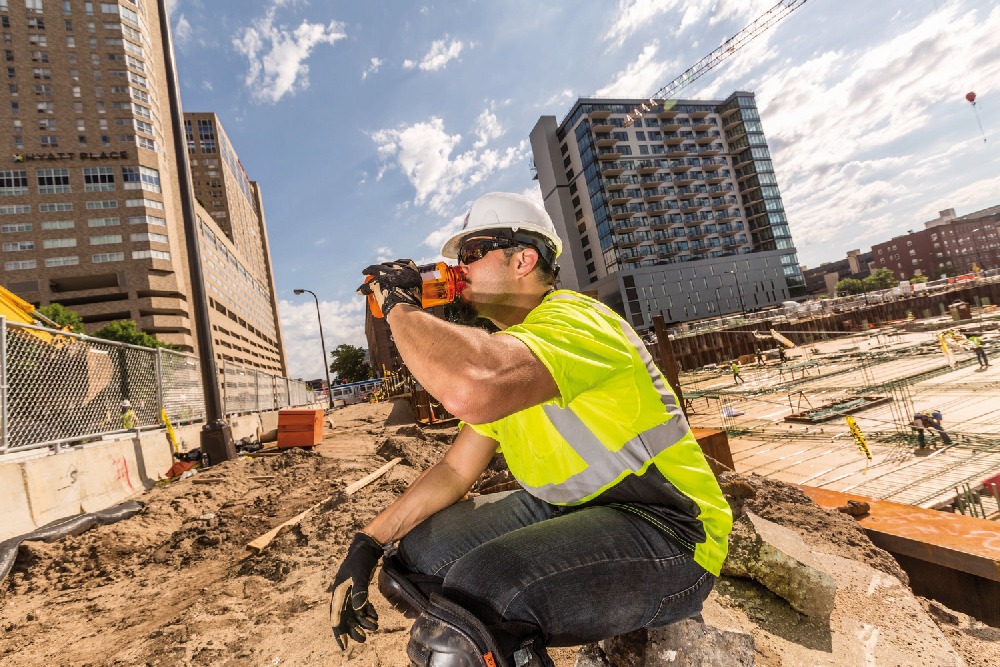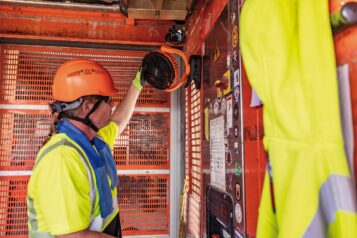
How water, rest + shade to get the work done
By Taylor Klitzke
With drastic, seasonal weather changes in many parts of the country, it’s a good time to review the extra precautions that must be taken to protect our workers. On occasion, workers may be required to work in hot environments for long periods, and when the human body is unable to maintain normal temperature, heat-related illnesses can occur. Every year, thousands of workers become sick from exposure to heat, and several even die. To prevent heat-related illness and fatalities, superintendents must learn the signs of heat illness and what to do in an emergency.
Four main types of heat illness include heat stroke, heat exhaustion, heat cramps and heat rash. By being familiar with the following symptoms and first aid, superintendents can better ensure workers remain safe on the jobsite.
1. Heat stroke: A condition that occurs when the body becomes unable to control its temperature and can cause death or permanent disability
Heat stroke is a serious emergency. Signs and symptoms include high body temperature, unconsciousness, hot skin, rapid pulse and breathing, weakness, dizziness or headache. Immediate first aid is required. Move the victim to a cool place and immediately cool the worker by any available means (use ice and water from a jobsite cooler for example). Keep the head and shoulders slightly elevated. Monitor the airway, check to be sure the victim is breathing. Call for professional help or rush the heat stroke victim to a hospital immediately.
Prevention of heat illness is very important. Gradual adaptation to working in hot weather is a start. As the weather heats up, take a few short breaks during the day and, if possible, schedule heavy work so that it does not have to be accomplished during the hottest part of the day. Dress sensibly and drink plenty of water. Keep an eye out for potential heat injuries in co-workers.
Symptoms
- High body temperature
- Confusion
- Loss of coordination
- Hot, dry skin or profuse sweating
- Throbbing headache
- Seizures, coma
First Aid
- Request Immediate medical attention
- Move the worker to a cool, shaded area
- Remove excess clothing
- Apply cool water to their body
2. Heat exhaustion: The body’s response to excessive loss of water and salt, usually through sweating
Heat exhaustion signs include heavy sweating, weakness, fast pulse, normal body temperature, headache and dizziness, nausea and vomiting. First aid for heat exhaustion requires the worker to be moved to a cool place. Keep them lying down with their legs straight and elevated 8-12 inches. Apply cold packs, wet towels or just wet their clothing to cool them. Give the victim cold water only if he or she is conscious. If the victim loses consciousness or if no improvement is noted within 30 minutes, seek professional medical attention.
Symptoms
- Rapid heartbeat
- Heavy sweating
- Extreme weakness or fatigue
- Dizziness
- Nausea, vomiting
- Irritability
- Fast, shallow breathing
- Slightly elevated body temperature
First Aid
- Rest in a cool area
- Drink plenty of water or other cool beverages
- Take a cool shower, bath or sponge bath
3. Heat cramps: Affects workers who sweat a lot during strenuous activity. Sweating depletes the body’s salt and moisture levels
Heat cramps are muscle cramps. Typically, these cramps occur in the arms or legs, but they also may be felt in the abdominal or chest muscles. These cramps are caused by excessive body fluid loss through sweating. First aid includes moving the victim to a cool place, resting the cramping muscle and giving the person cool water.
Symptoms
- Muscle cramps, pain or spasms in the abdomen, arms or legs
First Aid
- Stop all activity and sit in a cool place
- Drink clear juice or a sports beverage, or drink water with food
- Avoid salt tablets
- Do not return to strenuous work for a few hours after the cramps subside
- Seek medical attention if you have heart problems, are on a low-sodium diet or if the cramps do not subside within one hour
4. Heat rash: The most common problem in hot work environments
Heat rash is caused by sweating and looks like a red cluster of pimples or small blisters.
Symptoms
- Red cluster of pimples or small blisters which usually appear on the neck, upper chest, in the groin, under the breasts and in elbow creases
First Aid
- Provide a cooler less humid work environment
- The rash area should be kept dry
- Powder may be applied to increase comfort
- Ointments and creams should not be used on a heat rash as anything that makes the skin warm or moist may make the rash worse
 A complete heat illness prevention program should be implemented at each jobsite. The policy should include making sure adequate supplies of water are readily available, allowing for rest and shade, gradually increasing workloads, and allowing more frequent breaks for new workers or for those who have been away for a week or more to help them to acclimatize and build a tolerance for working in the heat. When specific tasks require the use of non-breathable synthetic or heavy clothing (e.g., Tyvek suits, welding garments, etc.), enhanced controls need to be in place to minimize heat stress.
A complete heat illness prevention program should be implemented at each jobsite. The policy should include making sure adequate supplies of water are readily available, allowing for rest and shade, gradually increasing workloads, and allowing more frequent breaks for new workers or for those who have been away for a week or more to help them to acclimatize and build a tolerance for working in the heat. When specific tasks require the use of non-breathable synthetic or heavy clothing (e.g., Tyvek suits, welding garments, etc.), enhanced controls need to be in place to minimize heat stress.
In addition, superintendents should ensure workers should drink water every 15 minutes, even if they’re not thirsty; rest in the shade to cool down; wear a hat and light-colored clothing; keep an eye on fellow workers and take it easy on the first days of working in the heat. Instilling these precautions can mean the difference between life and death.
Information for OSHA’s heat safety tool app can be found at: https://www.osha.gov/SLTC/heatillness/heat_index/heat_app.html
101 heat stress sources can be found at: https://www.safetyawakenings.com/cool-tips-for-working-in-extreme-heat-heat-stress-tips free/?utm_source=hootsuite&utm_campaign=hootsuite
Taylor Klitzke is safety coordinator at Kraus-Anderson Construction.
Images courtesy of Kraus-Anderson


 Join our thriving community of 70,000+ superintendents and trade professionals on LinkedIn!
Join our thriving community of 70,000+ superintendents and trade professionals on LinkedIn! Search our job board for your next opportunity, or post an opening within your company.
Search our job board for your next opportunity, or post an opening within your company. Subscribe to our monthly
Construction Superintendent eNewsletter and stay current.
Subscribe to our monthly
Construction Superintendent eNewsletter and stay current.